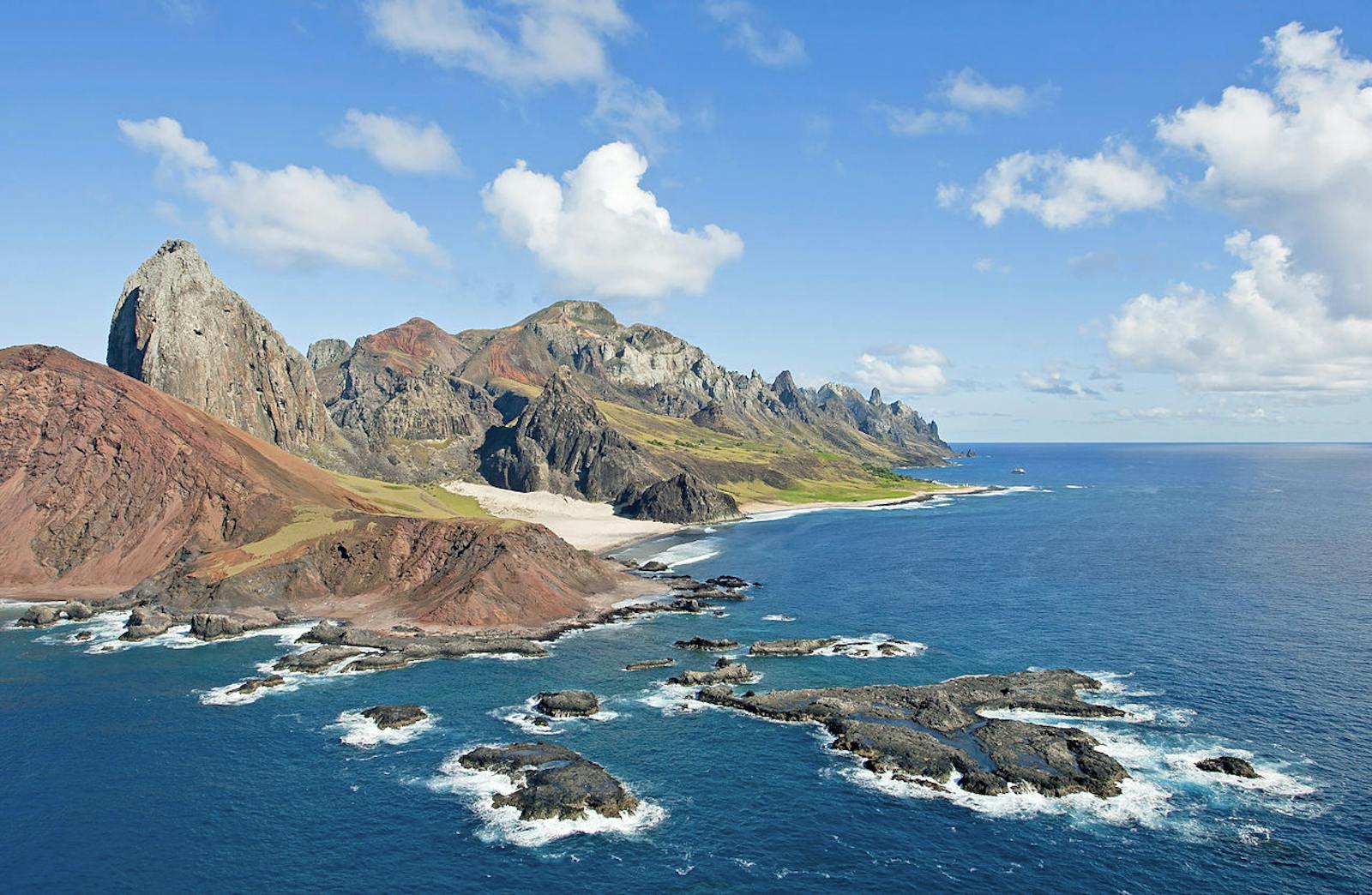Trindade-Martin Vaz Islands Tropical Forests
The ecoregion’s land area is provided in units of 1,000 hectares. The conservation target is the Global Safety Net (GSN1) area for the given ecoregion. The protection level indicates the percentage of the GSN goal that is currently protected on a scale of 0-10. N/A means data is not available at this time.
Bioregion: Brazilian Atlantic Moist Forests (NT14)
Realm: Southern America
Ecoregion Size (1000 ha):
1
Ecoregion ID:
509
Conservation Target:
97%
Protection Level:
9
States: Brazil
The Trindade petrel breeds on the remote island of Trindade and on the islet of Pedro Segundo within the Martin Vaz island group within this tropical forest ecoregion. Their aerial courtship displays make this species easily visible along the shorelines. Native flora and fauna like the petrels still dominate the natural habitats on the island, since the only human residents are Brazilian Navy personnel which man an outpost.
Lacking natural predators, remote island groups like this make important breeding sites for ground nesting sea birds, whose eggs and chick are vulnerable for several months of the year. Accidental introductions of rats, cats, or other common castaways can pose a huge threat to island species.
.jpg)
The flagship species of the Trindade-Martin Vaz Islands Tropical Forests ecoregion is the Trindade petral. Image credit: Birding Aboard, Creative Commons
The Trindade and Martin Vaz Archipelago is the most eastward point of Brazilian territory and is a result of volcanic activity deep below the Atlantic Ocean. Trindade is 1,140 km from the mainland and is about 14 km2 in area, with steep and rugged terrain reaching 600 m elevation at 3 different points. The Martin Vaz islets are visible from Trindade 42 km to the east, considerably small with similar terrain covered in grasses and shrubs. The archipelago has a tropical oceanic climate, with an annual mean temperature of 25°C. Daily rain showers, locally called pirajá, generally last for just five minutes.
A forest dominated by glandular nakedwood covered 85% of Trindade until the mid 1700’s, when Portuguese colonists arrived. At some point during this period or after, the island’s trees were almost entirely eliminated. Possible explanations for this die-off involve volcanic gas, overgrazing by the introduced goats, a decrease in rainfall, or most likely, fire set by humans. Small areas today still retain this tree on Trindade, but characteristic vegetation consists of the endemic tree fern Cyathea coelandii (6 m in height), the introduced Peperomia beckeri, grasses, shrubs, and herbs.
Likely the most impressive fauna of the Trindade-Martin Vaz Archipelago are the islands’ large populations of seabirds. This archipelago is the only place where the great frigatebird—a seabird common in Indo-Pacific ocean—can be found in the Atlantic. Although the frigatebird spends most of its life at sea, it is rarely seen swimming, since its feathers are not waterproof. Instead of catching their own fish, frigatebirds often steal a catch from other seabirds. These other seabrids include Trindade petrel, red-footed booby, white tern, brown noddy, phoenix petrel, and sooty tern.
Trindade is also the most important nesting ground for green sea turtle in all of Brazil, supporting some 1,800 nests per year on 3 km of sandy beach. Peak nesting occurs from January through March and the hatchlings are predated by the native crab Geocarcinus lagostoma. These crabs can be observed throughout the island from the beaches to the island’s highest point, Pico do Desejado (620 m).
The Trindade-Martin Vaz Archipelago has no permanent settlement, though Trindade is visited by researchers and periodically occupied by teams from the Brazilian Navy. In 1957, the Brazilian Navy established the Oceanographic Station of the Trindade Island (POIT), and since then there have been frequent expeditions for meteorological observations and attempts to reforest the island. Brazil's national Marine Turtle Protection and Research Program (TAMAR-IBAMA Project) has also conducted work on the island since 1982 with support from the Navy.
Due to its remoteness from the mainland, rugged terrain, and the lack of tourist facilities, the archipelago is practically, if not officially, free of any tourism activities. Nonetheless, past human interference has led to dramatic losses of biodiversity on Trindade Island. Without any suppression by natural predators, introduced goats, sheep, pigs, feral cats, and mice have flourished in number, causing severe destruction to the island’s vegetation and soils.
Many endemic plant and animal species are presently considered extinct. Despite extensive searches, at least 21 plant and 15 animal species previously registered on Trindade have not been found again since 1965. The priority conservation actions for the next decade will be to: 1) remove introduced species; 2) establish reintroduction and restoration of native vegetation; and 3) formalize protection measures.
Citations
1. Trowbridge, L. 2019. Islands off the coast of eastern Brazil. https://www.worldwildlife.org/ecoregions/nt0172 Accessed June 9, 2019.
2. Almeida, F.F.M. 2000. The island of Trindade. Geological and Paleontological sites of Brazil-092. Retrieved (2001) from: http://www.unb.br/ig/sigep/sitio092english.htm
3. Moreira, L., C. Baptistotte, J. Scalfone, J. C. Thomé, and A. P. L. S. de Almeida. 1995. Occurrence of Chelonia mydas on the Island of Trindade, Brazil. Marine Turtle Newsletter 70: 2.
4. BirdLife International 2018. Pterodroma arminjoniana. The IUCN Red List of Threatened Species 2018: e.T22698005A132618884. http://dx.doi.org/10.2305/IUCN.UK.2018-2.RLTS.T22698005A132618884.en. Accessed June 9, 2019.



